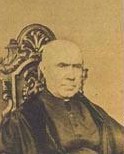A pioneer in the development of electrical science, Nicholas Joseph Callan was born on 22 December 1799 in Darver, Ireland. He started the priesthood at Navan Seminary, and continued his studies at St. Patrick’s College Maynooth, where he studied natural and experimental philosophy under Dr. Cornelius Denvir. After his ordination as priest in 1823, Callan pursued his doctorate in divinity in Rome, where he became acquainted with Galvani and Volta’s work in the study of electricity, and recognized the potential to put it to practical and commercial use with powerful batteries. In 1826, Callan returned to Maynooth as the new chair of natural philosophy, where he also began working with electricity in his basement laboratory at the college. Influenced by the work of his friend William Sturgeon, the inventor of the first electromagnet, and the work of Michael Faraday and Joseph Henry on the induction coil, Callan began work on the idea of the induction coil in 1834. He developed his first induction coil in 1836.
In addition to this achievement, Callan built the first successful mechanical current breaker, which he called a “repeater.” He was the first to establish the link between rate-of-change of current and electromagnetic induction, and discovered the principle of the self-exciting dynamo. Callan also built the most powerful batteries and electromagnets of his time, including a giant battery of 577 cells, and patented a method for protecting iron from rust, an early form of galvanization. Callan died at Maynooth on 10 January 1864.



